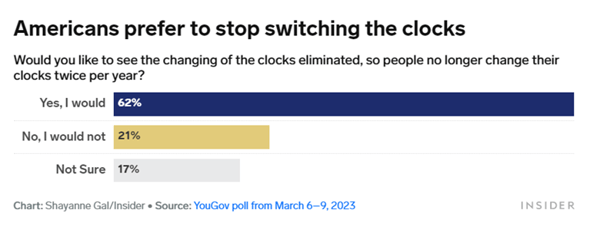 Each spring the United States and some 70 other countries move their clocks forward one hour for Daylight Savings Time (DST)—and then back again in the fall. This annual ritual was originally implemented to grant people an additional hour of sunlight after work in the summer. But is manipulating time the best solution for this “problem”?
Each spring the United States and some 70 other countries move their clocks forward one hour for Daylight Savings Time (DST)—and then back again in the fall. This annual ritual was originally implemented to grant people an additional hour of sunlight after work in the summer. But is manipulating time the best solution for this “problem”?
Some people delight in DST’s two temporary benefits: (questionable) energy conservation and an extra hour of sunlight squeezed in before bedtime. However, many folks lament its numerous disruptions and dangers: clock and schedule adjustments, sleep disturbances, heart attacks, car accidents, diminished productivity, and—surprisingly—negative agricultural impacts. Recent polls have revealed that 62 percent of Americans would like to see the twice-a-year time tweak abolished.
Despite citizens’ call for the end of DST and a stalled bill to make Daylight Savings Time permanent, we’ve just gone through the clock changing process again. And will continue for the foreseeable future.

This a glaring example of an outdated solution and arbitrarily continuing a discordant process—a process that failed to deliver its intended benefits and created havoc.
Sound familiar?
Evaluating Processes for Value Acceleration
Healthcare organizations need process efficiency, accuracy, and optimal value. Occasionally, however, in that quest for the ultimate trifecta, some organizations lose focus on their original goals or mistakenly select the wrong solution to a problem.
To this end, healthcare organizations can possibly learn a few things from the annual Daylight Savings ritual through the lens of Genzeon’s three-part value acceleration methodology:
- Focused Value: Select the projects and processes that have the highest impact with the greatest chance for success.
- Hidden Value: Look beyond just money saved and money earned to the many secondary benefits that can be achieved.
- Scalable Value: Form a repeatable process to ensure process improvement does not result in bottlenecks.
"Like using a sledgehammer to open a pile of nuts, a national directive to literally change time is a blunt approach to reach a goal."
Examples of Value Acceleration Methodology Applied to Business
Process Change Does Not Have to Be Enterprise-Wide
With DST, politicians mandated a country-wide solution for an issue with mixed results across society. DST primarily benefits 9-5 workers who gain the extra hour of daylight after work—resulting in more economic activity. Second and third shifters only garnered schedule adjustments, sleep disruptions, and other unfathomable outcomes. Not to mention that the entire paradigm of set business hours has been changed in the mobile, digital era.
Healthcare Takeaway: Organizations shouldn’t make assumptions that all processes need to be enterprise-wide to be worth implementing. Careful analysis of how the changes will affect each department and process is critical and can prevent unnecessary disruption and stalled progress.
Be Certain Your Problem Is Actually a Problem
For the previous 300,000 years before DST, Homo sapiens had been managing quite well without a twice-yearly time change edict. Many could argue that darkness settling in around 8 to 9 PM wasn’t a genuine problem—no one mandated a national bedtime and businesses could select their preferred hours, as some do seasonally already.
Healthcare Takeaway: Before transforming a process, organizations should first focus on the end goals: What are we trying to fix and why? Is it a true problem? What are the unintended side effects of this change? As the old adage states: “If it ain’t broke, don’t fix it.”
Determine the Right Solution for the Right Problem
Like using a sledgehammer to open a pile of nuts, a national directive to literally change time is a brutish approach to reach a goal. While other options may have been more difficult to implement, those options may have ultimately caused less overall disruption and negative side-effects.
Healthcare Takeaway: Organizations must make certain that they’ve selected the right tool for their process transformation. An improper solution could end up triggering more problems down the road. Process and proposed solutions should be carefully assessed to ensure the most appropriate solution is executed. Working with seasoned experts can help this process—but be wary of vendors who promote onlyone solution.
Don’t Remain Stagnant with Bad Processes
Though there appears to be substantial affirmation that the time change ignites more problems than it solves, the federal government seems unwilling or unable to decide on how to move forward. With equal popular support for permanent daylight and permanent standard times, the status quo continues—the least popular option of all.
Healthcare Takeaway: On the flip side of changing a process for sake of change, there is the unwillingness to transform a process that isn’t working out of fear or complacency. Organizations must also be willing to reverse or alter a solution that isn’t working. Again, change does not need to be unveiled enterprise-wide immediately—it can be piloted across individual departments.
- - -
As your body adjusts to the time change this week, don’t forget the lessons learned from our semiannual shift.
Learn more about how Genzeon helps healthcare organizations with their digital transformations and accelerate value on our Healthcare site.



